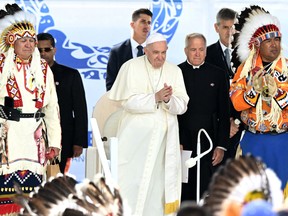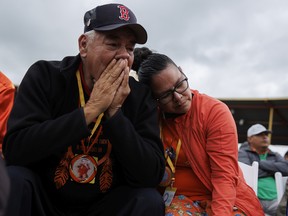Opinion: A common reaction to the pope was that more effort is needed to make practical improvements in people’s lives.

.
Flying to Canada to apologize to Indigenous Peoples less than a year after being asked, Pope Francis revealed how much he cares about what his church imposes on them.
Announcement 2
.
The response of Canadians, indigenous and not, varied across the map after the Pope apologized for “the evil perpetrated by not a few Catholics who contributed to the policies of cultural assimilation.” Many expressed their gratitude, while others criticized him for falling short.
Where do Canada and Catholicism go from here with respect to First Nations, Inuit and Métis?
In some ways, it is surprising that the physically ill 85-year-old pontiff flew to Canada for five days of events, given that he is responsible for 1.4 billion Catholics.
The entire population of Canada adds up to less than 1/40 of the faithful of their church. One-third of Canada’s 35 million citizens consider themselves Roman Catholic, as do approximately one-third of the country’s 1.6 million indigenous people.
Announcement 3
.
Still, at three separate events in Canada, he chose to put a global spotlight on the 125 federally funded residential schools attended by an estimated 150,000 First Nations people. Sixty percent of the schools were run by Catholic orders, particularly Oblates.
It is not the first time that this pontiff has apologized to the Indigenous Peoples. The Argentine Jesuit, the first pope from outside Europe, also “humbly asked for forgiveness” in South America for the sins and crimes committed by the Catholic Church against the indigenous peoples during the so-called conquest of the Americas.
In Canada, many residential school survivors and others, indigenous and non-indigenous, expressed their respect to the pope for bringing his apologies to North America. Countless people appeared enamored in the presence of a man widely considered humble, who has more “Liberal” and “Left” views than virtually any pope from millennia past.
Announcement 4
.
Yet another cohort of Canadians was decidedly unimpressed, journalists in particular.

The media’s suspicious narrative reaches a significant audience. The Catholic Church in Canada, despite being the largest religious group in the country and made up almost equally of people born here and abroad, is a tough sell here.
Although a 2015 Angus Reid Institute poll found that two out of three Canadians admire Pope Francis, the same pollster found this year that 24 percent of Canadians believe that Roman Catholicism has been harmful to the nation, while 21 percent think it has been beneficial. Most of the rest think it has had no real impact. Islam does a little worse than Catholicism. But Canadians’ positive assessments of Protestantism, Judaism, Sikhism, Buddhism, Judaism and atheism outweigh negative ones.
ad 5
.
There is no doubt that the Roman Catholic Church has been slow to apologize, especially compared to the way Anglican and United Church leaders publicly lamented their churches’ role in schools more than 30 years ago. The Oblates had apologized in 1991, but higher Catholic authorities held back, apparently for legal reasons.
Last year, Prime Minister Justin Trudeau was the most high-profile person to push for the pope to fly to Canada. Though some suggest Trudeau was shifting blame away from Ottawa, which founded and (under)funded schools in 1881 before most closed in the 1970s, the prime minister has regularly extended former Conservative prime minister Stephen Harper’s apology. from 2008.
ad 6
.
The two biggest media talking points to emerge from the Pope’s apology revolved around the terms “doctrine of discovery” and “genocide.”
The activists wanted Pope Francis to rescind the doctrine of discovery, which the Vatican, with the Spanish and Portuguese monarchies, produced in 1493 to claim the right to “discovered” lands from explorers. Legal scholars, however, say the Doctrine has been ignored for centuries and was not applied to the colonization of Canada, ever since the British king in 1763 issued the Royal Proclamation confirming the existence of Aboriginal title. The Canadian Conference of Catholic Bishops will publish a statement on the convoluted subject.
Francis also acknowledged to reporters on the plane back to Rome that he believed what happened to Canada’s indigenous people was “genocide.” By using the technical term that the UN also applies to the extermination of six million Jews in the Holocaust, the Pope went further than Canada’s Truth and Reconciliation Commission, which refers to the collective trauma of schools as “genocide.” cultural”.
ad 7
.
And what of the spark that ignited the pope’s visit: the media explosion in the spring of 2021 after it was announced that potentially hundreds of unmarked graves had been found at the site of the former Kamloops residential school and others? When the New York Times repeatedly reported that “mass graves” had been discovered, the story went viral worldwide.
But when the Pope arrived, things were more complicated. Some journalists, like the National Post Terry Glavin, a veteran writer on indigenous affairs who believes that residential schools amount to cultural genocide, went to great lengths to explain how the actual remains of the students have not been exhumed. Media editors began requiring reporters to change their references to “suspicious” graves.
ad 8
.
The exact number of student graves that exist may not be the crux for most Canadians, indigenous people, and others. An earlier survey by Angus Reid found that seven in 10 Canadians believe “cultural genocide” occurred in residential schools and that Canada has a moral obligation to improve life on reservations.
Some common indigenous people expressed a common opinion about the Pope’s apology. They discussed the need to go beyond symbolic acts and an emphasis on the meaning of thorny concepts. They suggested that more productive energy be put into the practicalities of reconciliation.
That means working together to continue tackling poverty and suicides among indigenous peoples, increasing employment levels, getting more young people into higher education, and moving further with multibillion-dollar business partnerships, whether in forestry, natural gas or indigenous-led urban real estate developments. .
ad 9
.
Although the Truth and Reconciliation Report was published in 2015, many indigenous and other Canadians have been working on the process for four decades or more. The Pope’s historic apology to Canada in 2022, though seen by some as highly flawed, made ongoing efforts to mend relations seem all the more dynamic. With good will, there seems to be little to stop it continuing for generations to come.
-
Douglas Todd: With anger and prayer: First Nations Catholics have a different view of residential schools
-
Douglas Todd: Genocide. pogrom. Crime against humanity. words matter
-
Douglas Todd: Lack of employment is a key cause of ‘deaths of despair’ among indigenous peoples




